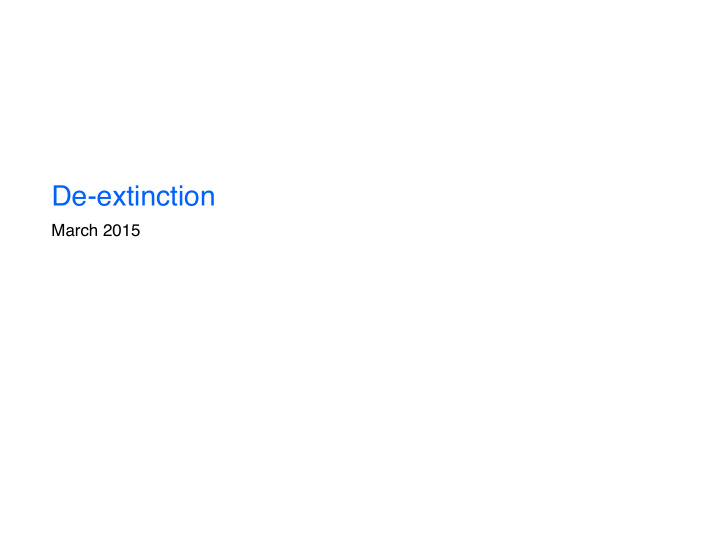



De-extinction March 2015
What is it • The process of creating an organism, which is a member of or resembling an extinct species. � � • Extract DNA from fossils, parts of animals or other articles. � � • By using their DNA and selectively breeding, or cloning. � � • De-extinction, resurrection biology, species revivalism.
Methods Cloning: create genetically identical organisms Selective breeding Scottish Blackface Finn-Dorset (Cytoplasmic Donor) (Nuclear Donor) Enucleation Mammary Cells Direct Current Pulse Blastocyst Surrogate ewe Dolly http://en.wikipedia.org/wiki/Cloning http://en.wikipedia.org/wiki/Selective_breeding
Some ongoing projects using cloning passenger pigeon (extinct beginning 20th century) Extracting DNA fragments from preserved specimens, and later, using band-tailed pigeons or rock pigeons as surrogate parents Pyrenaen Ibex (extinct 2000) http://en.wikipedia.org/wiki/Passenger_pigeon First animal that survived de-extinction by cloning (2009), but died of lung defect
Some ongoing projects using cloning woolly mammoth (extinct 10000 years ago) Large amounts of well-preserved mammoth tissue found in Siberia. � � Clone woolly mammoth using elephant as surrogate mother. � � Introduce mammoths in Pleistocene Park, wildlife reserve in Siberia. � � Planning stage as of 2013. http://en.wikipedia.org/wiki/Woolly_mammoth
An ongoing project using selective breeding aurochs (extinct in 1600’s) Use DNA samples from bone and teeth fragments in museums to recreate its full genome. � � Compare to DNA of modern European cattle to determine which breeds still carry aurochs genes. � � Undertake a selective breeding program to reverse the evolutionary process, in several generations. http://en.wikipedia.org/wiki/Aurochs
Candidate species for de-extinction and de-extinction criteria http://longnow.org/revive/species/
Controversy • Increased bio-diversity, potential new resources � • Compensate for human responsibility on extinction � � • No access to the epigenetics, which has a central importance in modulating DNA expression � • Different behaviours than predecessors, since raised by parents of different species � • Habitat necessary for formerly extinct species to survive is too limited to warrant de-extinction � • Potential serious impact on existing ecosystem by disruption of food chain � • Efforts would be better spent conserving existing species � • …
Further information • http://longnow.org/ � • http://longnow.org/revive/events/tedxdeextinction/ � • http://en.wikipedia.org/wiki/De-extinction
… …
Recommend
More recommend